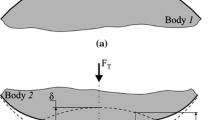Abstract
A posteriori error estimation in finite element analysis serves as an important guide to the meshing tool in an adaptive refinement process. However, the traditional posteriori error estimates, which are often defined in the energy or energy-type norms over the entire domain, provide users insufficient information regarding the accuracy of specific quantities in the solution. This paper describes an adaptive quadrilateral refinement process with a goal-oriented error estimation, in which a posteriori error is estimated with respect to the specified quantity of interest. A highlight of this paper is the demonstration of tools described in the paper used in a practical industrial environment. The performance of this process is demonstrated on several practical problems where the comparison is with the adaptive process based on the traditional error estimation.












Similar content being viewed by others
References
Zienkiewicz OC, Zhu JZ (1987) A simple error estimator and adaptive procedure for practical engineering analysis. Int J Numer Meth Eng 24:337–357
Lee JM (1997) MSC/Nastran Version 69+ Linear Static Analysis User’s Guide, The MacNeal-Schwendler Corporation
Zienkiewicz OC, Zhu JZ (1992) Superconvergent patch recovery techniques and a posteriori error estimation, part I: The recovery technique. Int J Numer Meth Eng 33:1331–1364
Zienkiewicz OC, Zhu JZ (1992) Superconvergent patch recovery techniques and a posteriori error estimation, Part II: Error estimates and adaptivity. Int J Numer Meth Eng 33:1365–1382
Ainsworth M, Oden JT (1997) A posteriori error estimation in finite element analysis. Comput Meth Appl Mech Eng 142:1–88
Oden JT, Prudhomme S (2001) Goal-oriented error estimation and adaptivity for the finite element method. Comput Math Appl 41:735–756
Prudhomme S, Oden JT, Westermann T, Bass J, Botkin ME (2003) Practical methods for a posteriori error estimation in engineering applications. Int J Numer Meth Eng 56(8):1193–1224
Botkin ME, Wentorf R, Karamete BK, Raghupathy R (2001) Adaptive refinement of quadrilateral finite element shell meshes AIAA-2001–1400. In: Proceedings of the AIAA SDM Conference, Seattle, WA,16–19 April 2001
Karamete BK, Garimella RV, Shephard MS (1999) Edge recovery method on an existing surface mesh for boundary layer meshing. In: Proceedings of the Fifth US National Congress on Computational Mechanics, 2nd Symposium on Trends in Unstructured Mesh Generation, Boulder, CO, 4-6 August 1999
Owen SJ, Staten, Canann SA, Saigal S (1999) Q-Morph: an indirect approach to advancing front quad meshing. Int J Numer Meth Eng 44:1317–1340
Lee CK, Lo SH (1994) A new scheme for the generation of a graded quadrilateral mesh. Comp Struct 52:847–857
Kinney P (1997) Clean up: improving quadrilateral finite element meshes. In: Proceedings of the 6th International Meshing Roundtable, Park City, UT, 13–15 October 1997
De Cougny HL, Shephard MS (1999) Parallel refinement and coarsening of tetrahedral meshes. IJNME 46:1101–1125
Blacker TD, Stevenson MB (1991) Paving: a new approach to automatic quadrilateral meshing technique. Adv Eng Software 13(5–6):811–847
Mantle JB, Dolan TJ (1948) A photoelastic study of stresses in U-shaped members. Proc Soc Exp Stress Anal 6(1)
EDS Corporation (2004) http://support.ugs.com/docs/ug/v18/. Cited 2004
Botkin ME (2000) Modeling and optimal design of a carbon fiber reinforced composite automotive roof. Int J Eng Comput 16(1):16–23
Author information
Authors and Affiliations
Corresponding author
Rights and permissions
About this article
Cite this article
Botkin, M.E., Wang, HP. An adaptive mesh refinement of quadrilateral finite element meshes based upon a posteriori error estimation of quantities of interest: linear static response. Engineering with Computers 20, 31–37 (2004). https://doi.org/10.1007/s00366-004-0271-9
Received:
Accepted:
Published:
Issue Date:
DOI: https://doi.org/10.1007/s00366-004-0271-9




